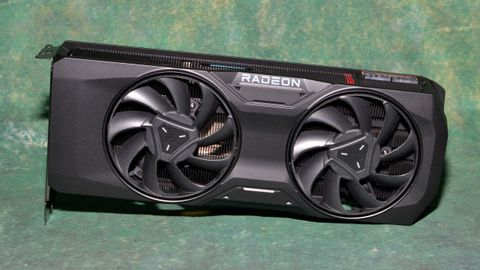Radeon RX 7800 XT AI Performance
GPUs are also used with professional applications, AI training and inferencing, and more. Along with our usual professional tests, we've added Stable Diffusion benchmarks on the various GPUs. AI is a fast-moving sector, and it seems like 95% or more of the publicly available projects are designed for Nvidia GPUs. Those Tensor cores aren't just for DLSS, in other words, but AMD now has "AI Accelerators" in RDNA 3 to help boost FP16 performance for such workloads. Let's start with our AI testing and then hit the professional apps.
We're using Automatic1111's Stable Diffusion version for the Nvidia cards, while for AMD we're using a recent Nod.ai Shark variant — we've retested all the AMD cards for this review using build version 20230713_819, as results have improved substantially compared to our previous testing. Intel meanwhile has finally has an OpenVINO fork of Automatic1111's webui, which shows about a 50% improvement over our previous testing. We've retested those cards as well, now with Stable Diffusion 2.1 and 768x768 results.
As we've seen before, AMD doesn't really match up well with Nvidia or even Intel when it comes to AI number crunching operations. The RDNA 3 GPUs do offer substantial improvements over their predecessors, as the RX 7800 XT ends up with about 40–45 percent higher Stable Diffusion image generation rates compared to the RX 6800 XT. However, against Nvidia, that's only enough to nip at the heels of the bottom rung RTX 4060 for 512x512 images, while the 4060's 768x768 performance still beats the 7800 XT by 50%.
If we look at GPUs that carry a similar price, it's even more lopsided. The RTX 4060 Ti — both 8GB and 16GB models — can do 512x512 images about 40% faster than the RX 7800 XT, and 768x768 images at nearly double the AMD rate. Intel's Arc A770 also makes AMD look anemic, with 44% faster 512x512 image generation and 48% faster 768x768 results.
Perhaps things will continue to improve as more projects get optimized for AMD's RDNA 3 architecture. That feels like a stretch, though, as most companies and people working with AI will want the fastest hardware they can get, and that's likely going to keep them in the Nvidia camp. If RDNA 4 finally brings serious matrix cores to AMD's consumer lineup, rather than keeping them exclusive to the data center CDNA offerings, that's what it would take to truly close the gap.
Radeon RX 7800 XT Professional Workloads
While AMD's AI results with the RX 7800 XT aren't spectacular, the SPECviewperf 2020 v3 results are much better. There are eight different benchmarks, and we use the geometric mean from those to generate an aggregate score — that's not an official score, but it gives an easy way of at least approximating overall performance. Few professionals use all these programs, however, so it's generally more important to look at the results for the application(s) you plan to use.
AMD and Nvidia both have professional GPUs and drivers that offer even better performance in many of these applications, but AMD tends to unlock more performance on its consumer hardware than Nvidia. To that end, the RX 7800 XT overall leads the RTX 4060 Ti by 154%. And it's not just due to one or two results (though the 1465% lead in Siemens NX certainly helps): The RX 7800 XT beats the RTX 4060 Ti in every single one of these tests, by a minimum margin of about 50%.
What about Intel Arc? For now, the less said the better. Granted, it's a less expensive graphics card, and drivers continue to improve. But for many of these professional applications, we'd be leery of Arc right now. The 7800 XT is often two or three times faster, and it's over 100 times faster in snx-04.
But as we've noted before, if you're really using one or more of these applications in a professional capacity, upgrading to a professional graphics card — even if it costs two or three times as much — isn't the worst idea. Time is money, after all.
For GPU accelerated 3D rendering, the only app that currently supports all three GPU vendors is Blender. It now leverages the ray tracing hardware to boost performance, and that generally puts Nvidia into the pole position.
For AMD GPUs, Blender Benchmark 3.5.0 performance (which is faster than 3.6.0 based on our testing) seems to have changed in the past month or two. It's likely thanks to new driver optimizations from AMD, so we retested all of the AMD GPUs for the Navi 32 launch and things are now up to date. We also retested the Arc A770 16GB, using Blender Benchmark 3.6.0, as that improved performance quite a bit.
AMD's RX 7800 XT ends up underperforming a bit compared to our gaming benchmarks, falling behind the RX 6800 XT by around 20%. What's interesting is that our previous RX 6000-series results were all lower than the current 7800 XT score, but the new RX 6000 results have improved by about 30% compared to our previous testing. But that's still nowhere near Nvidia, where even the RTX 4060 beats the top AMD result and the 4060 Ti is nearly double the 7800 XT score in Blender.
Intel's Arc A770 16GB also does decently overall, considering its price. It now lands between the RX 6800 and RX 7800 XT.
Radeon RX 7800 XT Content Creation Summary
Overall, the content creation, AI, and professional workloads story for the RX 7800 XT ends up being a case of the extremes. Either it does really well, like in SPECviewperf, or it does poorly, like in AI and 3D rendering. You can use the 7800 XT for these tasks, but there are often better options if any of these workloads represent your primary use case.
- MORE: Best Graphics Cards
- MORE: GPU Benchmarks and Hierarchy
- MORE: All Graphics Content


